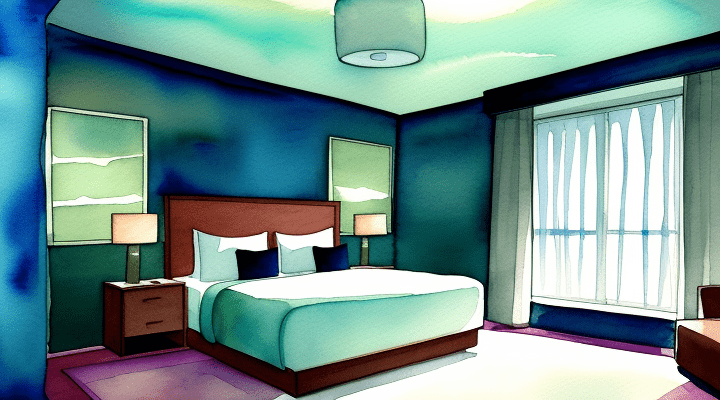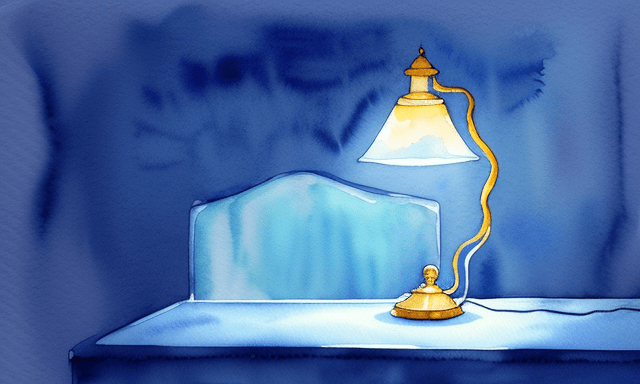
In a world filled with constant noise and distractions, finding solace in a peaceful night’s sleep can sometimes feel like an elusive dream. However, there is a simple yet powerful tool that can help transform your sleep experience and bring tranquility to your restless nights: white noise. In this article, we will explore the benefits of using white noise to improve your sleep, reduce anxiety, and promote relaxation. We’ll answer the following questions:
- Is it good for you to sleep with white noise?
- What is the most relaxing sound to sleep to?
- How does white noise help with sleep anxiety?
- Is it okay to leave white noise on all night?
- What are the side effects of white noise?
- What is the difference between pink noise and white noise?
- What noise makes you fall asleep faster?
- What color noise is best for anxiety?
White noise is a type of sound that contains an equal intensity across the frequency spectrum of human hearing. It is often described as a consistent, unobtrusive background noise that can help mask other sounds in the environment. It is widely used as a sleep aid, but did you also know that white noise can reduce stress?
From its ability to mask disruptive sounds to its soothing effect on the nervous system, discover how harnessing the power of white noise can create a harmonious environment for rest and rejuvenation. Say goodbye to sleepless nights and embrace the symphony of serenity that white noise can provide.
Is it good for you to sleep with white noise?
Sleeping with white noise can be beneficial for many people. White noise refers to a consistent sound that covers up other sounds in the environment, such as the hum of a fan or the sound of rain. It can help create a soothing and consistent background noise that masks other disruptive sounds, making it easier for some individuals to fall asleep and stay asleep.
White noise can be particularly helpful in environments where there are external noises that may disturb sleep, such as traffic, loud neighbors, or a partner’s snoring. By providing a constant and predictable sound, white noise can help drown out these disturbances and promote a more restful sleep.
Additionally, white noise can have a calming effect on the nervous system. It can help to reduce the brain’s sensitivity to sudden noises and create a more relaxing sleep environment. This can be especially beneficial for individuals who are light sleepers or who have difficulty falling asleep due to anxiety or racing thoughts.
However, it’s important to note that the effectiveness of white noise can vary from person to person. Some individuals may find it helpful, while others may not notice any difference or may even find it distracting. It’s a matter of personal preference and what works best for each individual.
If you’re considering using white noise to improve your sleep, I recommend experimenting with different types of white noise, such as a fan, a white noise machine, or a smartphone app, to find what works best for you. It’s also important to use white noise at a volume that is comfortable and not too loud, as excessive noise can be counterproductive and disrupt sleep.
What is the most relaxing sound to sleep to?
The most relaxing sound to sleep to can vary from person to person, as individual preferences and experiences differ. However, there are a few sounds that are commonly reported to be soothing and conducive to sleep:
White noise
As mentioned earlier, white noise is a consistent and steady sound that can help mask other noises and create a calming environment for sleep. Examples of white noise include the sound of a fan, static, or a white noise machine. Ambient Soundscapes features a library of the most relaxing white noise available.
Nature sounds
Many people find the sounds of nature, such as gentle rain, ocean waves, or a soft breeze, to be relaxing and sleep-inducing. These natural sounds can evoke a sense of tranquility and help create a peaceful sleep environment.
Ambient music
Soft and calming instrumental music, such as classical music or ambient tracks, can also promote relaxation and sleep. Look for music with a slow tempo and minimal variations in volume to avoid any sudden disruptions.
ASMR
Autonomous Sensory Meridian Response (ASMR) refers to a tingling sensation that some individuals experience in response to specific auditory or visual triggers. ASMR videos often feature soft whispers, gentle tapping, or other soothing sounds that can help induce relaxation and sleep.
Ultimately, the most relaxing sound to sleep to is subjective and may require some experimentation to find what works best for you. It’s important to choose sounds that you personally find soothing and that help create a peaceful sleep environment.
How does white noise help with sleep anxiety?
Sleep anxiety refers to the feeling of worry or restlessness that can interfere with falling asleep or staying asleep. It can be caused by various factors, such as racing thoughts, stress, or a heightened sensitivity to external noises.
Masks disruptive sounds
White noise provides a consistent background sound that can help mask unwanted noises in the environment. This can be particularly beneficial for individuals who are easily disturbed by sudden or unpredictable sounds, such as traffic, sirens, or household noises. By covering up these disruptive sounds, white noise can create a more soothing and predictable sleep environment, reducing anxiety and promoting better sleep.
Promotes relaxation
The steady and repetitive nature of white noise can have a calming effect on the nervous system. It can help to drown out racing thoughts and create a sense of relaxation, making it easier to fall asleep. The consistent sound of white noise can also serve as a form of auditory stimulation that distracts the mind from anxious thoughts, allowing for a more peaceful sleep experience.
Some research suggests that white noise may help activate the body’s relaxation response, a physiological state characterized by reduced heart rate, blood pressure, and muscle tension. This relaxation response can counteract the effects of stress and promote a sense of calm and well-being.
Establishes a healthy sleep routine
Using white noise consistently as part of a bedtime routine can help signal to the brain that it’s time to relax and prepare for sleep. By associating the sound of white noise with sleep, it can become a cue for the body and mind to unwind, reducing anxiety and promoting a more restful sleep.
It’s important to note that while white noise can be helpful for sleep anxiety, it may not be a standalone solution for everyone. If you’re experiencing significant sleep anxiety or insomnia, it’s advisable to consult with a healthcare professional who can provide personalized guidance and support. They can help identify the underlying causes of your sleep anxiety and recommend appropriate strategies or treatments to address it effectively.
Is it okay to leave white noise on all night?
Many people find that continuous white noise can create a soothing and consistent sleep environment, masking other sounds and promoting better sleep. In general, it is safe to leave white noise on throughout the night if it helps you sleep.
However, it’s important to use white noise at a volume that is comfortable and not too loud. Excessive noise, including white noise, can potentially disrupt sleep and have negative effects on your hearing health. It is recommended to keep white noise machines at a volume below 50 decibels, which is similar to the sound level of a quiet conversation.
Additionally, it’s worth noting that while white noise can be beneficial for many individuals, it may not be necessary or effective for everyone. Some people may find it distracting or prefer a quieter sleep environment. It’s a matter of personal preference and what works best for each individual.
If you choose to use white noise throughout the night, I recommend using a device specifically designed for generating white noise or a smartphone app that provides a continuous and consistent sound. It’s also a good idea to place the device at a safe distance from your bed to minimize any potential negative effects of prolonged exposure to noise.
As always, if you have any concerns or questions about using white noise or its impact on your sleep, it’s best to consult with a healthcare professional who can provide personalized advice based on your specific situation.
What are the side effects of white noise?
White noise is generally considered safe and does not have significant side effects for most people. However, there are a few considerations to keep in mind:
Listening at high levels can harm hearing
It’s important to listen to white noise at a volume that is comfortable and not too loud. Prolonged exposure to loud noise, including white noise, can potentially damage your hearing. To protect your hearing, it’s recommended to keep the volume of white noise machines or devices below 50 decibels, which is similar to the sound level of a quiet conversation.
Becoming dependent on white noise
Some individuals may become reliant on white noise to fall asleep. While this is not inherently harmful, it’s worth noting that relying solely on white noise for sleep may make it more challenging to sleep in environments without white noise, such as when traveling or during power outages. It can be helpful to gradually wean off white noise if you find yourself overly dependent on it.
Masking out too much sound
White noise can effectively mask other sounds in the environment, but it may also mask important sounds, such as smoke alarms, doorbells, or other safety-related noises. It’s important to ensure that you can still hear important auditory cues while using white noise, especially if you have specific safety concerns.
While many people find white noise soothing and beneficial for sleep, it may not be suitable or effective for everyone. Some individuals may find it distracting or prefer a quieter sleep environment. It’s important to listen to your own preferences and adjust your sleep environment accordingly.
What is the difference between pink noise and white noise?
Pink noise and white noise are both types of random sound signals, but they differ in their frequency distribution and perceived sound characteristics.
White noise contains all frequencies of sound
White noise is a signal that contains equal energy across all frequencies within the audible range. It is often described as a “hissing” or “static” sound and has a flat frequency spectrum. White noise contains all audible frequencies at equal intensity, from low to high pitches. It is a random and continuous sound that can effectively mask other sounds in the environment.
Pink noise dials in the mid to low end frequencies
Pink noise, on the other hand, has a different frequency distribution compared to white noise. It is characterized by a decrease in power (energy) as the frequency increases. In other words, pink noise has more energy in the lower frequency range and less energy in the higher frequency range. This results in a sound that is deeper and more bass-heavy compared to white noise. Pink noise is often described as a “running shower” or “waterfall” sound.
The term “pink noise” is derived from the color spectrum, where pink light has a similar power distribution as pink noise in the frequency domain. Pink noise is considered to have a more balanced and natural sound compared to white noise, as it mimics the frequency distribution found in many natural sounds.
Both white noise and pink noise can be used for various purposes, including promoting relaxation, masking background noise, and aiding sleep. Some individuals may find one type of noise more soothing or preferable than the other, depending on personal preference and sensitivity to different frequencies.
It’s worth noting that there are other types of colored noise as well, such as brown noise (also known as red noise) and blue noise, which have different frequency distributions and perceived sound characteristics.
What noise makes you fall asleep faster?
The noise that makes you fall asleep faster can vary from person to person, as individual preferences and sensitivities differ. However, there are a few types of noise that are commonly reported to be soothing and conducive to sleep:
1. White noise
White noise, with its consistent and steady sound, can help mask other noises in the environment and create a soothing sleep environment. It can be particularly effective for individuals who are easily disturbed by sudden or unpredictable sounds.
2. Pink noise
Pink noise, which has a balanced frequency distribution with more energy in the lower frequency range, can also be relaxing and promote sleep. It is often described as a deeper and more bass-heavy sound, similar to the sound of rushing water or rustling leaves.
3. Nature sounds
Many people find the sounds of nature, such as gentle rain, ocean waves, or chirping birds, to be calming and sleep-inducing. These natural sounds can evoke a sense of tranquility and create a peaceful sleep environment.
4. Ambient music
Soft and calming instrumental music, such as classical music or ambient tracks, can also help induce relaxation and sleep. Look for music with a slow tempo and minimal variations in volume to avoid any sudden disruptions.
Ultimately, the noise that helps you fall asleep faster is subjective and may require some experimentation to find what works best for you. It’s important to choose sounds that you personally find soothing and that create a peaceful sleep environment. Additionally, using noise at a volume that is comfortable and not too loud is crucial for a restful sleep experience.
What color noise is best for anxiety?
When it comes to managing anxiety, different individuals may find different types of noise helpful. While white noise may be the go to sound for getting to sleep, some people find pink noise to be relaxing and helpful for reducing anxiety, creating a soothing environment and promoting a sense of calmness.
It’s important to note that individual preferences can vary, and what works for one person may not work for another. It may require some experimentation to find the type of noise or sound that is most effective in reducing your anxiety. Additionally, it’s always a good idea to consult with a healthcare professional or therapist who can provide personalized guidance and support for managing anxiety.






